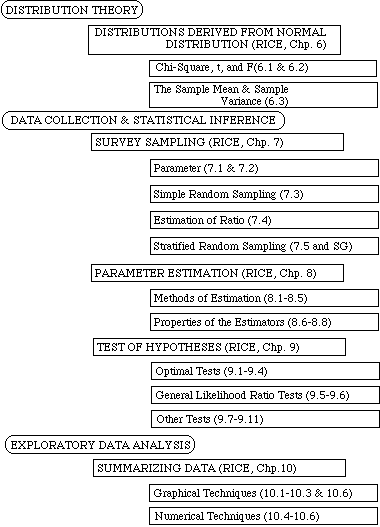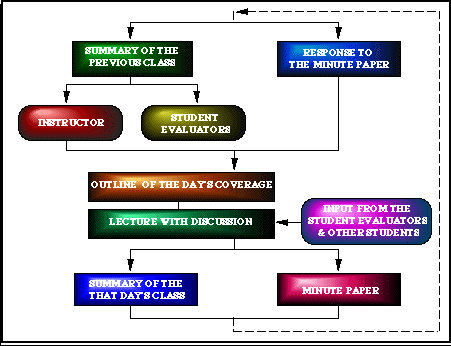|
|
|
|
| MATH. 3611 | |
| SPRING, 1999 | |
| COURSE WEB SITE | http://mnstats.morris.umn.edu//introstat/ |
| # OF CREDITS : | 4 |
| PREREQUISITE: | MATH. 3610 OR # |
| DAYS & TIME: | 11:00-11:50 |
| BUILDING & ROOM: | SS. 124 |
| INSTRUCTOR: | Dr. Engin A. Sungur |
| OFFICE: | 253 SCIENCE |
| TELEPHONE: | x6325 |
| OFFICE HOURS: | MTWThF, 1-2 |
| sungurea@caa.morris.umn.edu |
COURSE DESCRIPTION:
The topics from Mathematical Statistics such as; survey sampling,
estimation of parameters and fitting probability distributions, Testing
hypothesis and assessing goodness of fit, summarizing data, comparing two
sample, the analysis of variance, linear least squares will be covered.
Data analytical approach to mathematical statistics will be followed.
MINITAB and SYSTAT computer statistical packages will be used.
GOALS OF THE COURSE:
COURSE MATERIALS: (i) John A. Rice, Mathematical Statistics and Data Analysis (Second Edition), Wadsworth and Brooks/Cole Statistics/Probability Series, 1995 (The text book is the most recent and comprehensive book in this area. The author believes that separating theory and data analysis is artificial, so the textbook provides a nice balance between theory and practice. It can be used as a source book. Its wide and updated coverage makes it a good investment.)
(ii) Study Guide
EXAMINATION POLICY: Two midterm examinations and a final
exam will be given. Time table for the examinations is given below:
| MIDTERM 1 | APRIL, 20 (Tuesday) | SS. 124 | 11:00-11:50 |
| MIDTERM 2 | MAY, 20 (Thursday) | SS. 124 | 11:00-11:50 |
| FINAL | JUNE, 10 (Tuesday) | SS. 124 | 9:30-11:30 |
EACH EXAMINATION (INCLUDING THE FINAL) WILL BE CLOSED-BOOKS AND CLOSED-NOTES.
HOMEWORKS: Eight homeworks will be assigned. No late homeworks
will be accepted without a valid excuse. Solutions will be available
at the following class.
| HOMEWORKS: | 20% |
| MIDTERM EXAMS: | 50% |
| FINAL EXAM: | 30% |
PLEASE FEEL WELCOME TO SEE ME OUTSIDE OF THE CLASS, ANY
TIME, IF YOU HAVE QUESTIONS, PROBLEMS, OR COMMENTS
PERTAINING THE COURSE WORK.
The detailed syllabus of the course is given in the following table.
|
READINGS |
|
|
I. DISTRIBUTIONS DERIVED FROM THE NORMAL DISTR.; |
RICE, 177 |
|
II. SURVEY SAMPLING; |
RICE, 185 |
|
III. ESTIMATION; |
RICE, 239 |
|
IV. HYPOTHESIS TESTING; |
RICE, 299 |
|
V. SUMMARIZING DATA; |
RICE, 345 |
|
VI. COMPARING TWO SAMPLE; |
RICE, 387 |
|
VII. ANALYSIS OF VARIANCE; |
RICE, 443 |
|
VIII. LINEAR LEAST SQUARES; |
RICE, 507 |
 |
The organization of the in-class activities are summarized in the following flowchart. The main components of the organization structure are:
(i) Summaries and Outline: These two components, hopefully,
will provide a smooth transition between the topics and lectures.
These will answer three basic questions: Where have we been?,
Where are we going?, and What have we learned?

(ii) Student Evaluators: Class participation and discussion are very important on the learning process. Students are encouraged to ask questions in the class. Questions, comments could help the instructor to set up his/her pace. The input from the students should be constant. If you point out the weaknesses of the instructor, and the problems with the course in general as soon as possible your learning process will be enhanced. To formalize and promote active learning, each in-class activity will be evaluated by the two students. These students will be responsible to point out all the problems that might affect the learning of the rest of the class. For example, the topics that are not clearly covered, pace of the lecture, use of the blackboard, problems with taking notes, etc.Time to time student evaluators will be asked to make a summary of the previous class.
|
STUDENT EVALUATOR |
DATE 1 |
DATE 2 |
|
Eugen Barbu |
3/29,30 |
5/10,11 |
|
Laura Eisenmenger |
4/1,2 |
5/13,14 |
|
Gina Garding |
4/5.6 |
5/17,18 |
|
James Harman |
4/8,9 |
5/20,21 |
|
Brent Heeringa |
4/12,13 |
5/24,25 |
|
James Johnson |
4/15,16 |
5/27,28 |
|
Debra Kielhold |
4/19,20 |
6/1,3,4 |
|
Thomas Kluis |
4/22,23 |
3/29,30 |
|
Joel Leet |
4/26,27 |
4/1,2 |
|
dave Logan |
4/29,30 |
4/5.6 |
|
Chad Logid |
5/3,4 |
4/8,9 |
|
Paul Olson |
5/6,7 |
4/12,13 |
|
David Rausch |
5/10,11 |
4/15,16 |
|
Rufino Rodriguez |
5/13,14 |
4/19,20 |
|
Christopher Schmillen |
5/17,18 |
4/22,23 |
|
Michael Schwerin |
5/20,21 |
4/26,27 |
|
Christopher Sieling |
5/24,25 |
4/29,30 |
|
Maren Vikan |
5/27,28 |
5/3,4 |
|
Daniel Wolters |
6/1,3,4 |
5/6,7 |
(iii) Minute paper: Time to time you will be asked to answer the following three questions:
1. What was the most important thing you learned today?
2. What was the most important thing you learned yesterday?
3. What questions are uppermost in your mind as we conclude this
class session?
Answers to these questions will help the instructor on setting
up her/his pace, pin-point the topics that the students are having
problems on understanding, to correct misunderstanding etc. The
questions are related with effectiveness of the lecture, retention
of the information delivered, and effectiveness of the teaching
in general.
The topics that will be covered are mostly in the text book. If
a topic is not in your textbook, then it will be pointed out in
the lecture and/or handouts will be provided.
Exams will cover the material discussed in the class and
the readings in the text. Before the exam, an information sheet
will be provided. This information sheet (worksheet) will
include (a) place and date of the examination, (b) the detailed
topics that will be covered in the examination, (c) the tools
that students must bring to the examination (such as statistical
tables, calculators etc.). One day before the exam, the topics
that will be included in the exam will be reviewed, and
important points that should be remembered will be pointed out.
Right after the examination, the students will get the solutions.
The anticipated grading time of the exams is 1 day.
The students should plan on taking the exam on the scheduled date.
Illness (Health Service Excuse) or a Chancellor's excuse will
be honored as a reason for taking the exam at other than the scheduled
date. (Make-ups creates a data which is not independent and identically
distributed. As you will learn in this course, lack of these properties
creates a big problem on the inference based on such data).
No late homeworks will be accepted without a valid excuse.
The difficulty of the exams will be so arranged that there will
be no need for the "normalization" of the scores based
on the Gaussian Distribution (known as making a curve). Trends
on the scores, attendance to the lectures, class participation
etc. will be considered on the determination of the final grades.
|
|